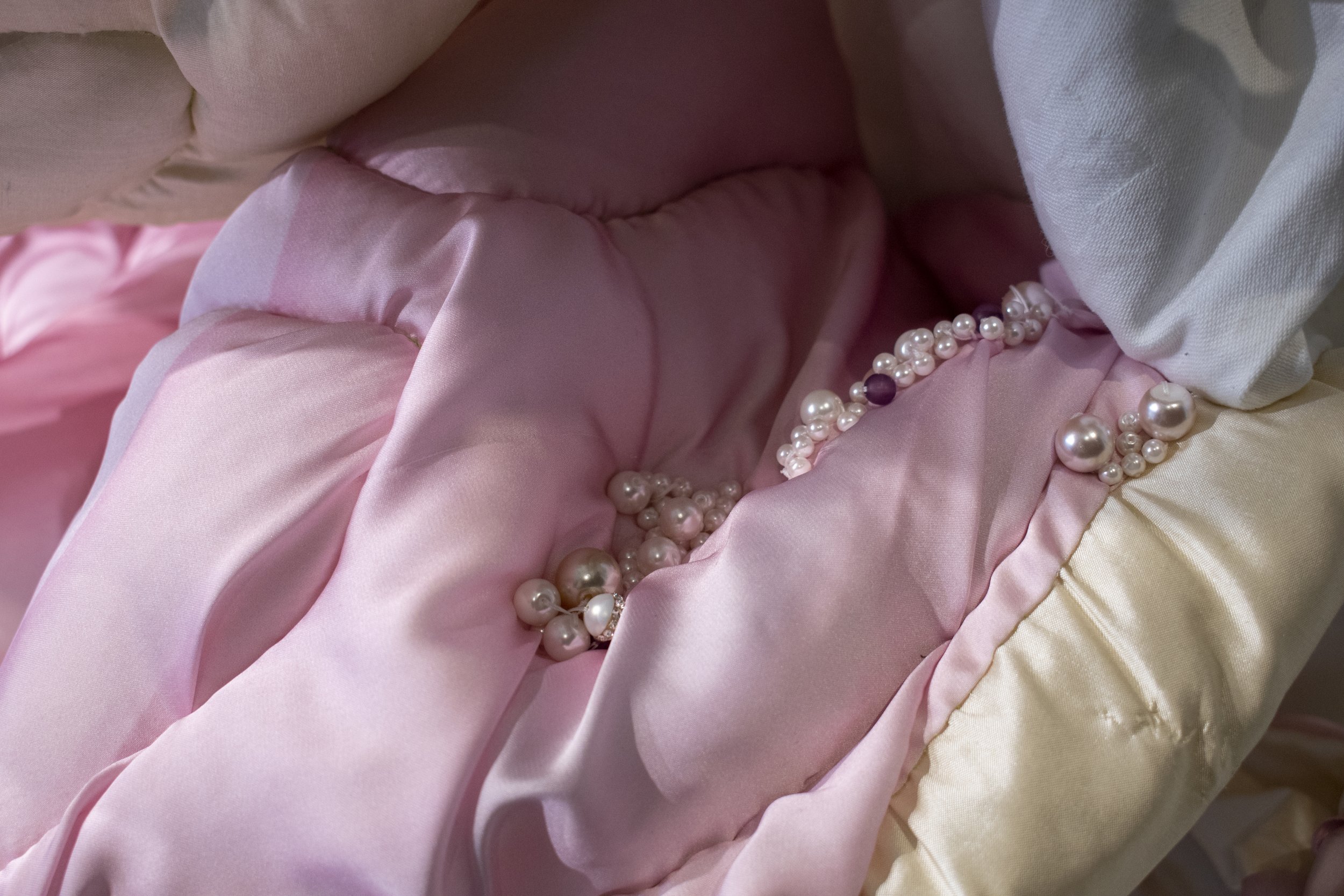'Susanna and the Others' (After Gentileschi), Kate Howe, 2022, installation, oil paint and oil pastel with wallboard transfer and stitching on Belgian linen, with silk frame and textile elements, painting dimensions: 220 x 488 cm, silk frame constructed by Jowan John. Installation View at the Dyson Gallery.
‘Susanna and the Others (After Gentileschi)’
Kate Howe, 2022, installation, oil paint and oil pastel with wallboard transfer and stitching on Belgian linen, with silk frame and textile elements, painting dimensions: 220 x 488 cm, silk frame constructed by Jowan John. Collection: Susanna, Installation, Painting.
"One of the reasons I'm attracted to Gentileschi's piece is because I studied it closely when I did my BA in Art History. I saw it in person during the Gentileschi show at the National Gallery (the first show they've ever given to a woman) and something about it was so different than any other version painted. Perhaps it's a
reflection of the fact that the painter was a woman, or a reflection of the fact that the painter was a 16 year old woman who had been raped.
What I notice about all of her work, is that she chooses her moment. Gentileschi's painting is an inverted pyramid of power, the men above her and the "camera" running in tight to the story so that we are with her, moments before they touch her. Gone is the pastoral beauty usually put into the scene, and we are left with violation and inevitability.
I thought of victim blaming, upskirting, revenge porn, and mostly I thought of agency, and Susanna's lack of. Susanna became a stand-in for me, for all women and non-binary people."
- Excerpts from Kate's writing on 'Susanna and the
Others'.
“I first encountered Artemesia Gentileschi's 1610 painting Susanna and the Elders in person in August of 2020, the week that I moved to London. It was scorching hot, my mother was here, having helped us cross the ocean with our few remaining belongings, our two children and our cats. We stood, blinking in the realization that we had done it, we had gotten out of the US, we had escaped the terrifying dumpster fire of our crumbling democracy.
In the brief breath between lockdowns, while my mother was still with us, when we still held hope that the pandemic would lift and life would be normal, Artemesia was here as well.
I remember trembling while walking up the sweeping back staircase under an enormous banner with her name: ARTEMESIA dominating the space above me. I remember feeling the weight of her imperious presence at the National Gallery. SHE trusts her work, that's for sure.
I remember wondering if the banner should have said GENTILESCHI instead. I didn't know how much parity to fight for, then. Now I know, it's the pirates' code. Take all there is. Give nuthin' back.
Susanna, though: Gentileschi's Susanna, painted when she was just sixteen. Startlingly different than all which came before. Gentileschi is powerful in part because of the moments she chooses. She waits, she lets the camera come close, she lets the story run forward. In Gentileschi's painting, the only one I could find on the subject painted by a woman, we are in tight, uncomfortably close to the action, just as Susanna is. Close enough their breath stinks.
In an inverted pyramid of power, the two elders loom over Susanna, forming a lintel to the plinth of her body as she flinches back. They are inescapable.
I thought about this moment, about choosing the moment. I thought about this story: what happens when the camera runs forward even further? What about the next day?
What happens to Susanna, say the next day, at the coffee shop? Who heard about this near-attack, was she really meeting someone and fucking under a tree? Who was he? Was she really almost raped? Is she lying?
I think about uncontrollable moments of shame, I think about upskirting and revenge porn and reporting. I think about victim-blaming and the exhaustion of the fear of not being believed. I think about the hope you feel when you trust and tell what happened, and the terrible, and very real social consequences which accompany that action, and the way the social landscape changes indelibly after an event like this occurs.
I think about the sensation of being cornered, implicated, stared at, dismantled, I think about the contradictory nature of both needing to be seen, and desperately needing the perpetrators and the crime to be the thing being seen, not Susanna. Susanna wishes she could describe this like it happened to someone else. Susanna is doing her best to stay whole.
Jowan John is a master tailor who helps me with complicated construction and is training me on industrial sewing. The silk frame for this piece was designed by Howe and constructed by Jowan John.”
- Kate Howe
‘Susanna and the Others’, Video tour, Dyson Gallery.











